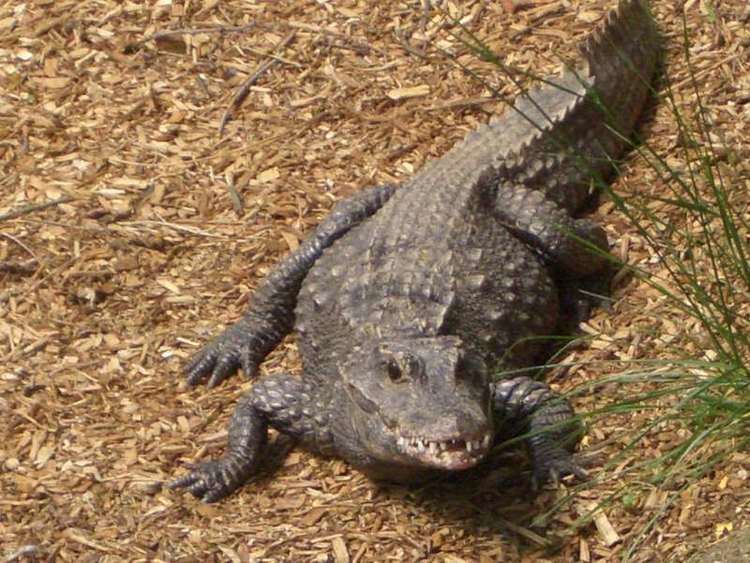Class Reptilia Family Crocodylidae Rank Species | Phylum Chordata | |
 | ||
Similar | ||
West african crocodile crocodylus suchus mauritania
The West African crocodile or desert crocodile (Crocodylus suchus) is a species of crocodile related to – and often confused with – the Nile crocodile (C. niloticus).
Contents
- West african crocodile crocodylus suchus mauritania
- Taxonomy
- Distribution
- Relationship with humans
- Conservation
- References

Taxonomy
The species was named by Étienne Geoffroy Saint-Hilaire in 1807, who discovered differences between the skulls of a mummified crocodile and those of C. niloticus. This new species was, however, for a long time afterwards regarded as a synonym of the Nile crocodile, but a 2011 study showed that all sampled mummified crocodiles from Egypt belonged to a different species than C. niloticus, and thereby resurrected the name C. suchus.
Distribution
The West African crocodile inhabits Mauritania, Benin, Nigeria, Niger, Cameroon, Chad, Central African Republic, Equatorial Guinea, Senegal, Mali, Guinea, Gambia, Burkina Faso, Ghana, Gabon, Togo, Ivory Coast, Democratic Republic of the Congo, Republic of Congo and Uganda (Uganda has both Nile and West African crocodiles). One C. suchus specimen also exists at the St. Augustine Alligator Farm Zoological Park, and pairs live in Copenhagen Zoo and Dublin Zoo.
West African crocodiles in Mauritania have adapted to their arid environment by staying in caves or burrows in a state of æstivation during the driest periods. When it rains, the reptiles gather at gueltas.
Relationship with humans
The people of Ancient Egypt worshiped Sobek, a crocodile-god associated with fertility, protection, and the power of the pharaoh. They had an ambivalent relationship with Sobek, as they did (and do) with C. suchus; sometimes they hunted crocodiles and reviled Sobek, and sometimes they saw him as a protector and source of pharaonic power. C. suchus was known to be more docile than the Nile crocodile and was chosen by the Ancient Egyptians for spiritual rites, including mummification. A recent DNA test found that all sampled mummified crocodiles from Grottes de Thebes, Grottes de Samoun, and Haute Egypt belonged to this species.
Sobek was depicted as a crocodile, as a mummified crocodile, or as a man with the head of a crocodile. The center of his worship was in the Middle Kingdom city of Arsinoe in the Faiyum Oasis (now Al Fayyum), known as "Crocodilopolis" by the Greeks. Another major temple to Sobek is in Kom-Ombo; other temples were scattered across the country.
Historically, C. suchus inhabited the Nile River in Lower Egypt along with the Nile crocodile. Herodotus wrote that the Ancient Egyptian priests were selective when picking crocodiles. Priests were aware of the difference between the two species, C. suchus being smaller and more docile, making it easier to catch and tame. Herodotus also indicated that some Egyptians kept crocodiles as pampered pets. In Sobek's temple in Arsinoe, a crocodile was kept in the pool of the temple, where it was fed, covered with jewelry, and worshipped. When the crocodiles died, they were embalmed, mummified, placed in sarcophagi, and then buried in a sacred tomb. Many mummified C. suchus specimens and even crocodile eggs have been found in Egyptian tombs.
Spells were used to appease crocodiles in Ancient Egypt, and even in modern times Nubian fishermen stuff and mount crocodiles over their doorsteps to ward against evil.
In modern times, Mauritanian traditional peoples who live in close proximity to West African crocodiles revere them and protect them from harm. This is due to their belief that, just as water is essential to crocodiles, so crocodiles are essential to the water, which would permanently disappear if they were not there to inhabit it. The crocodiles live in harmony with the humans, and never attack swimmers.
Conservation
As late as the 1920s, museums continued to obtain C. suchus specimens from the Nile in Sudan.
